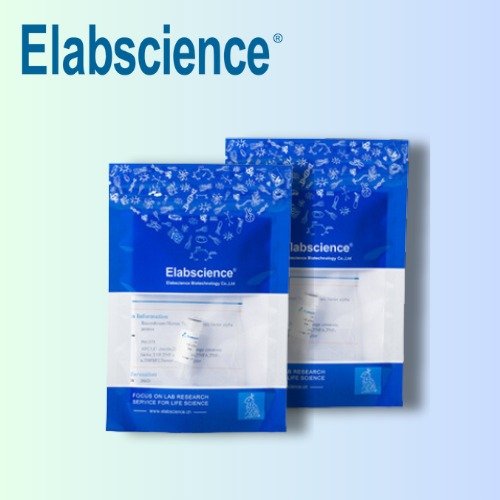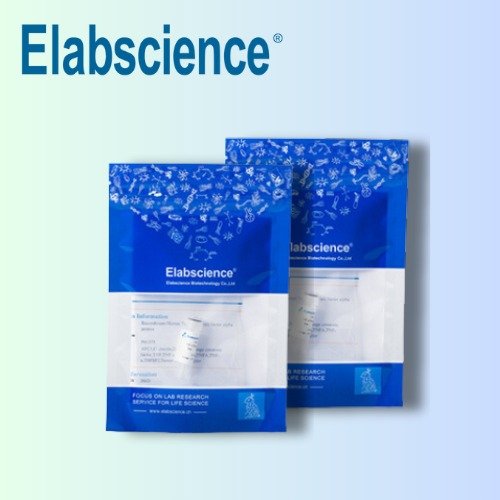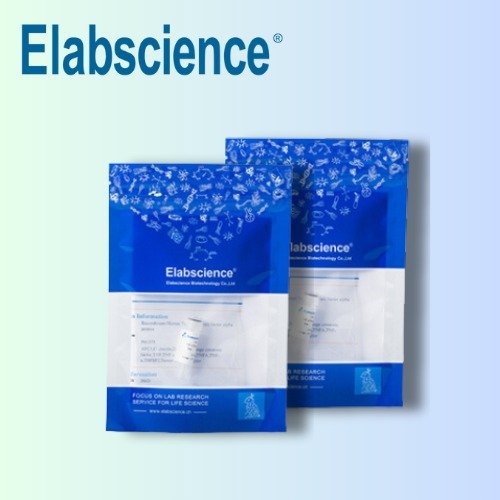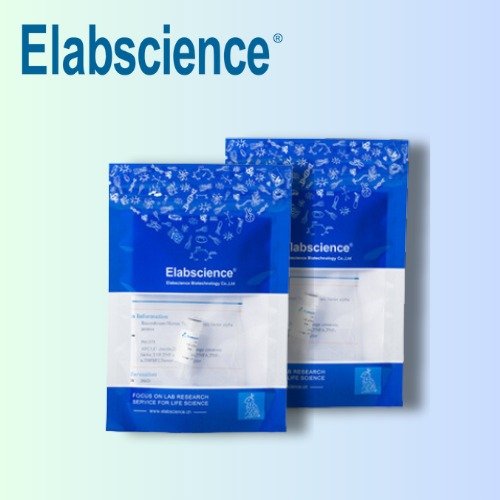Elabscience Protein
Elabscience Protein
Manufacturer: Elabscience
Macrophage colony-stimulating factor 1, also known as CSF-1, M-CSF, Lanimostim and CSF1, is a single-pass membrane protein which is disulfide-linked as a homodimer or heterodimer. Granulocyte / macrophage colony-stimulating factors are cytokines that act in hematopoiesis by controlling the production, differentiation, and function of 2 related white cell populations of the blood, the granulocytes and the monocytes-macrophages. M-CSF/CSF-1 is known to facilitate monocyte survival, monocyte-to-macrophage conversion, and macrophage proliferation. M-CSF/CSF-1 is a secreted cytokine which influences hemopoietic stem cells to differentiate into macrophages or other related cell types. It binds to the Colony stimulating factor 1 receptor. M-CSF/CSF-1 may also be involved in development of the placenta. The active form of M-CSF/CSF-1 is found extracellularly as a disulfide-linked homodimer, and is thought to be produced by proteolytic cleavage of membrane-bound precursors. M-CSF/CSF-1 induces cells of the monocyte/macrophage lineage. It also plays a role in immunological defenses, bone metabolism, lipoproteins clearance, fertility and pregnancy. Upregulation of M-CSF/CSF-1 in the infarcted myocardium may have an active role in healing not only through its effects on cells of monocyte/macrophage lineage, but also by regulating endothelial cell chemokine expression.
Manufacturer: Elabscience
TGF-beta RI, also called ALK-5, is an approximately 55 kDa type I transmembrane serine/threonine receptor kinase. In the presence of TGF-beta, TGF-beta RI forms a complex with, and is phosphorylated by, TGF-beta RII. Phosphorylated TGF-beta RI can then transiently bind and phosphorylate Smad2 and Smad3. TGF-beta functions as a tumor suppressor by inhibiting the cell cycle in the G1 phase. Administration of TGF-beta is able to protect against mammary tumor development in transgenic mouse models in vivo. Disruption of the TGF-beta/SMAD pathway has been implicated in a variety of human cancers, with the majority of colon and gastric cancers being caused by an inactivating mutation of TGF-beta RII. TGF-beta RI is likely important during development, since mice deficient for TGF-beta RI die at midgestation with severe defects in vascular development of the yolk sac and placenta, and an absence of circulating red blood cells. Furthermore, TGF-beta RI appears to be involved in proper lymphatic network development.
Manufacturer: Elabscience
Brain-Derived Neurotrophic Factor (BDNF) is a member of the neurotrophin family. Along with other structurally related neurotrophic factors NGF, NT-3 and NT-4, BDNF binds with high affinity to the TrkB kinase receptor. It also binds with the LNGFR (for low-affinity nerve growth factor receptor, also known as p75). BDNF promotes the survival, growth and differentiation of neurons. It serves as a major regulator of synaptic transmission and plasticity at adult synapses in many regions of the CNS. BDNF expression is altered in neurodegenerative disorders such as Parkinson's and Alzheimer's disease.
Manufacturer: Elabscience
Ephrins-A3 belongs the Ephrins ligand family which involved in a variety of biological processes, especially in the nervous system and in erythropoiesis. It is shown that Ephrin-A3 is expressed in brain, skeletal muscle, spleen, thymus, prostate, testis, ovary, small intestine, and peripheral blood leukocytes. Ephrin-A3 has a GPI anchor following the extracellular sequence and a signal sequence of 22 amino acids. Ephrin-A3 can bind EphA2, EphA3, EphA4, EphA5, EphA6, EphA7, EphA8 and EphB1. Futhermore, it is associated with tumor growth and metastasis.
Manufacturer: Elabscience
Weakly binds calcium but binds zinc very tightly-distinct binding sites with different affinities exist for both ions on each monomer. Physiological concentrations of potassium ion antagonize the binding of both divalent cations, especially affecting high-affinity calcium-binding sites. Binds to and initiates the activation of STK38 by releasing autoinhibitory intramolecular interactions within the kinase. Interaction with AGER after myocardial infarction may play a role in myocyte apoptosis by activating ERK1/2 and p53/TP53 signaling. Could assist ATAD3A cytoplasmic processing, preventing aggregation and favoring mitochondrial localization. May mediate calcium-dependent regulation on many physiological processes by interacting with other proteins, such as TPR-containing proteins, and modulating their activity.
Manufacturer: Elabscience
Transforming growth factor beta 1 (TGFβ1) is the prototype of a growing superfamily of peptide growth factors and plays a prominent role in a variety of cellular processes, including cell-cycle progression, cell differentiation, reproductive function, development, motility, adhesion, neuronal growth, bone morphogenesis, wound healing, and immune surveillance. TGF-β1, TGF-β2 and TGF-β3 signal via the same heteromeric receptor complex, consisting of a ligand binding TGF-β receptor type II (TβR-II), and a TGF-β receptor type I (TβR-I). Signal transduction from the receptor to the nucleus is mediated via SMADs. TGF-β expression is found in cartilage, bone, teeth, muscle, heart, blood vessels, haematopoitic cells, lung, kidney, gut, liver, eye, ear, skin, and the nervous system.
Manufacturer: Elabscience
Human β-Nerve Growth Factor (β-NGF) was initially isolated in the mouse submandibular gland. It is composed of three non-covalently linked subunits α; β; and γ; it exhibits all the biological activities ascribed to NGF. It is structurally related to BDNF; NT-3 and NT-4 and belongs to the cysteine-knot family of growth factors that assume stable dimeric structures. Β-NGF is a neurotrophic factor that signals through its receptor β-NGF; and plays a crucial role in the development and preservation of the sensory and sympathetic nervous systems. Β-NGF also acts as a growth and differentiation factor for B lymphocytes and enhances B-cell survival. These results suggest that β-NGF is a pleiotropic cytokine; which in addition to its neurotropic activities may have an important role in the regulation of the immune system. Human β-NGF shares 90% sequence similarity with mouse protein and shows cross-species reactivity.
Manufacturer: Elabscience
Serotransferrin belongs to transferrin family, and contains 2 transferrin-like domains. The protein is a secreted protein, and expressed by the liver and secreted in plasma. Transferrins are iron binding transport proteins which can bind two Fe3+ ions in association with the binding of an anion. It is responsible for the transport of iron from sites of absorption and heme degradation to those of storage and utilization. Serum transferrin may also have a further role in stimulating cell proliferation.
Manufacturer: Elabscience
Human Vitronectin/VTN is a cell adhesion and spreading factor. It can be found in the blood and the extracellular matrix (ECM). Vitronectin interacts with glycosaminoglycans and proteoglycans. The multimeric Vitronectin can efficiently bind to and incorporate into the ECM; Vitronectin can support cell adhesion through binding to various integrins and other proteoglycans. Vitronectin can be recognized by certain members of the integrin family and serves as a cell-to-substrate adhesion molecular. It can as a inhibitor of the membrane-damaging effect of the terminal cytolytic complement pathway. Vitronectin contains an endogenous cleavage site; plus cleavage sites for elastase; thrombin; and plasmin.









